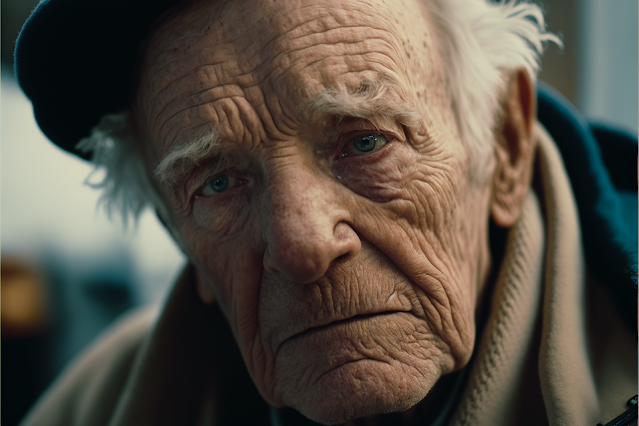Analysis of the concept/content of a studio production relevant to your pitched idea.
 |
| Extreme closeup, an elderly man, outdoors, melancholy. Cold Colours, complimentary contrast :: shot on kodak Portra800 film, f/1.4, soft light --ar 3:2 |
Prior to beginning this unit, I'd been introduced to AI art and began using online tools 'Dall-E' and 'Midjourney' to create my own. These tools were great, fantastic pieces of software, creating 'art' (The word itself can be challenged in this context (Dennis, 2022)) in mere moments that could easily pass as a Master's oil painting or a beautiful, melancholic portrait photograph of somebody who never existed.
The debate surrounding AI was something that absolutely absorbed me and took a large portion of my attention for some weeks and by the time this unit brief was presented, it seemed only appropriate that I created an idea that reflected this current, developing interest in some way. One of the interesting questions that AI posed was its interpretation of 'reality', and how easily it could create believable images and enthralling stories, poems or musings that you would believe could only come from a thinking, feeling human being.
I'd read many opinions of those discussing the topic of AI, both for and against, but thought to myself, why not get an opinion from the very thing itself, I asked Chat GPT how it thought the introduction and future development of AI software would impact Human Creativity...here's what it said.
This dabbling in AI got me thinking about the future of technology, and how we're on the precipice of Utopian or Dystopian advancements- which of those it falls under can only, sadly, be considered in hindsight. One of the most influential shows that thinks about these ideas was 'Black Mirror'. I wanted to produce a piece of work that also grappled with the Dystopian themes that often also shine a light on the potential harm that Technology can pose to individuals on a personal level or en masse to society as a whole. I was interested in the societal impact that Televisual media has specifically (Barry, 1997), as it is so incredibly broad reaching and has its tendrils grabbing at its audience in so many forms so I sought to look for a live TV show that capitalised felt like it had something more to say.
I remembered a fantastic programme - the one I'll be analysing here- that I watched a couple of years ago by Derren Brown in his series 'Experiments'. One of these experiments had stuck with me profoundly because it was so compelling in its misdirection and moral; something that I wanted to integrate into the show that I wanted to pitch (f you're not familiar with 'Remote Control', go watch it!).
I loved how the entirety of the show had a relatively shallow surface; a game show where the audience are involved in the narrative, told that they are in 'remote control' of an unwitting participant. During intervals throughout the show, actors are deployed upon the participant to carry out certain outcomes, each time, the audience are given the choice between a positive or a negative outcome e.g. Positive- A woman approaches the participant, flirting with him and giving him her number. Negative- She accuses him of touching her bum and her boyfriend (also an Actor) confronts him (Hargraves, 2023). Perhaps unsurprisingly, every time, the audience opts for televised schadenfreude; choosing to inflict a negative outcome upon the participant.
The show explores potent themes such as pack mentality and dissociation, which are big ideas to address in a seemingly innocuous format; something that was relevant to my own pitch and layering misdirection and falsehood into a magazine show.
 |
| The anonymous masked audience members in Remote Control |
What works so well in Remote Control, is that there is a story to tell, and one that is instantly relatable to the audience both at home, and in the studio. It's just an 'average Joe' on a night out with friends where throughout the evening, it can go either way; and with each decision, the stakes get higher and higher making the consequence more and more severe. This relatability, intertwined with a gradual building narrative was something that I wanted to integrate into my pitched idea. The script would have coincided with current news events making it believable to the audience and prime for the live format. I intended for it to gradually become more unusual as the show progressed, with stories that were "too good to be true" and glitch effects, revealing the true identities of the Presenters and exposing the fraudulent nature of the show. The final shot would have been a look behind the curtain with green screens on display, the actors from the 'news' stories sitting around, chatting, revealing the whole thing to be a hoax and making the viewer question their own values and how easily they can be led to believe something from a source that is seemingly legitimate.
This approach is interesting because it feels as though there's a shift in accountability, moving from the creator to the viewer and putting the onus on them to reflect on their own viewing habits and natural inclinations to believe simply what they are told.
BIBLIOGRAPHY
This person does not exist (2023) This Person Does Not Exist. Available at: https://thispersondoesnotexist.com/ (Accessed: February 8, 2023).
Dennis, S. (2022) The AI art debate: Excitement, fear and ethics, Medium. Towards Data Science. Available at: https://towardsdatascience.com/the-ai-art-debate-excitement-fear-and-ethics-c04d30f338da (Accessed: February 8, 2023).
Barry, A.M. (1997) Visual intelligence: Perception, image, and manipulation in visual communication. Albany: State University of New York Press.

Comments
Post a Comment